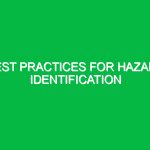In today’s world, where health and safety are paramount, understanding Safety Protocols for Biohazard Handling is crucial. These protocols are not just guidelines; they are essential practices designed to protect workers, the public, and the environment from the risks associated with biological hazards. The Health, Safety, and Environment (HSE) domain prioritizes the creation and enforcement of these protocols to ensure safe and effective handling of potentially dangerous substances. This article will delve into the importance of these safety measures, explore the various hazards associated with biohazards, outline best practices, and highlight the relevant regulations that govern biohazard handling.
Understanding Biohazards and Their Risks
Biohazards are biological substances that pose a threat to the health of living organisms, primarily humans. They include microorganisms such as bacteria, viruses, fungi, and parasites, as well as their toxins. Handling these agents without proper precautions can lead to serious health risks, including infections, diseases, and even death. The Centers for Disease Control and Prevention (CDC) categorizes biohazards into four biosafety levels (BSLs) based on their risk potential, with BSL-1 representing the lowest risk and BSL-4 the highest.
For instance, consider a laboratory environment where researchers work with pathogens. If proper safety protocols are not adhered to, a researcher might inadvertently expose themselves to a highly infectious virus, leading to an outbreak. Such incidents underscore the need for robust Safety Protocols for Biohazard Handling.
Identifying Hazards in Biohazard Handling
The first step in ensuring safety is to identify potential hazards. When handling biohazards, several risks can arise:
- Infectious Agents: These can include viruses, bacteria, and other pathogens that can cause disease.
- Exposure Risks: Direct contact with biohazardous materials can lead to infections.
- Environmental Contamination: Improper handling can result in the release of biohazards into the environment.
- Inadequate Disposal: Failing to dispose of biohazard waste correctly poses risks to both human health and the environment.
Each of these hazards demands a tailored approach to safety protocols. For example, when dealing with BSL-2 pathogens, which are associated with moderate hazards, workers must wear personal protective equipment (PPE) such as gloves, gowns, and face protection to mitigate exposure risks.
Best Practices for Safety Protocols in Biohazard Handling
Implementing effective safety protocols is essential in minimizing risks associated with biohazard handling. Here are some best practices that organizations and individuals should adopt:
1. Training and Education
All personnel involved in handling biohazardous materials should receive comprehensive training. This training should cover:
- The nature of biohazards
- Proper handling and disposal techniques
- Emergency procedures in case of exposure
- Use of PPE
Regular refresher training can keep safety protocols fresh in employees’ minds, ensuring compliance and reducing risks.
2. Use of Personal Protective Equipment (PPE)
PPE is a critical line of defense against biohazards. Depending on the level of risk, appropriate PPE may include:
- Gloves: To protect hands from direct contact.
- Lab Coats: To prevent contamination of personal clothing.
- Face Shields or Goggles: To protect eyes and face from splashes.
- Respirators: Necessary when working with aerosols or airborne pathogens.
It’s vital to ensure that PPE is correctly fitted and maintained. Regular inspections and replacements should be part of the protocol.
3. Implementing Engineering Controls
Engineering controls can significantly reduce exposure risks. Examples include:
- Biological Safety Cabinets: These provide a sterile environment for handling biohazards.
- Airflow Systems: Proper ventilation systems can help filter out airborne pathogens.
- Containment Facilities: Designated areas for biohazard work minimize the risk of cross-contamination.
Investing in these controls can offer a safer work environment and enhance compliance with safety regulations.
4. Proper Waste Management
Disposing of biohazardous waste is a critical component of safety protocols. All biohazard waste should be:
- Clearly labeled
- Collected in leak-proof containers
- Disposed of following local and federal regulations
For example, sharps such as needles should be placed in puncture-resistant containers to prevent injuries and contamination.
5. Emergency Response Plans
No protocol is complete without a robust emergency response plan. This plan should include:
- Procedures for spills or exposure incidents
- Contact information for emergency responders
- First aid measures
- Incident reporting protocols
Regular drills can help ensure that all personnel know how to respond swiftly and effectively in emergencies.
Regulations and Standards Governing Biohazard Handling
Numerous regulations govern biohazard handling, emphasizing the need for compliance to ensure safety. Key regulations include:
- Occupational Safety and Health Administration (OSHA): OSHA has established standards for bloodborne pathogens (29 CFR 1910.1030), which set forth requirements for exposure control plans and training.
- Centers for Disease Control and Prevention (CDC): The CDC provides guidelines for biosafety in microbiological and biomedical laboratories, categorizing biohazards into biosafety levels.
- Environmental Protection Agency (EPA): The EPA regulates the disposal of biohazardous waste under the Resource Conservation and Recovery Act (RCRA).
Staying updated on these regulations is vital for organizations involved in biohazard handling. Regular audits can help ensure compliance and identify areas for improvement.
Conclusion
The importance of Safety Protocols for Biohazard Handling cannot be overstated. By understanding the risks, implementing robust safety practices, and complying with relevant regulations, organizations can create a safer environment for their employees and the community at large. As someone who has worked in a laboratory setting, I can attest to the difference that diligent adherence to safety protocols makes. In one instance, a minor spill was contained swiftly due to well-practiced emergency procedures, preventing potential exposure to harmful pathogens. Such experiences highlight that preparedness and training are key in biohazard management.
Ultimately, the commitment to safety not only protects individuals but also fosters a culture of responsibility and awareness that extends beyond the walls of any organization. As we continue to navigate the complexities of biohazard handling, let’s prioritize safety at every level.


